

Back and forth, hither and yon – whether on my habitual trajectory between Touraine and Paris or further afield… destinations, encounters, events and observations I can’t resist sharing.

Just back from the department of Finistere on the southwest coast of Brittany. It’s a good thing the scenery is gorgeous because Brittany weather is consistently wet and windy. I did catch 2 sunny beach days at Pont-Aven one summer, but the sea was so cold it gave you a headache. If you thrive on the bracing coastal romance of Maine, Nova Scotia, west of Ireland and Scotland, then Finistere is for you.
The holy grail of windswept scenery is La Pointe du Raz, beyond the village of Plogoff – a rocky promontory notorious with sailors for intimidating waves and deadly currents. Tourists were kitted out in hiking sneakers and anoraks with a hood. It was far too blustery for an umbrella or a rain hat, unless tied tight under the chin (not a winning look even for babies).
Pointe du Raz is France’s Land’s End, and became a major tourist destination after Victor Hugo and Gustave Flaubert extolled its savage beauty. “Here is the end of the old world; behold its outer limit. Over your shoulders lie all of Europe and Asia; in front of you the ocean, the endlesss ocean.**” Technically Flaubert got it wrong, as there are two other Brittany outcroppings that extend a tad further into the Atlantic, but neither has comparably sublime scenery.
When crowds needed to be reined in at the risk of destroying the fragile ecosystem, Raz was designated a protected national park – one of France’s not-to-be-missed “Grand Sites”. Today’s pilgrimage is an orderly, didactic affair involving paid parking, a show-and-tell visitor’s center and jitney bus ride for the tired, infirm, lazy, or anyone who hopes to keep their hair looking good. On a clear day you can spy the low-lying island of Sein, just 5km offshore. Sein is a hardy fishing community with neither cars nor protected harbor, now threatened by rising sea levels. The sea was too rough for ferries to dock the day we were there.
Finistere is the cradle of Basse (or low) Brittany culture. Basse refers to the western half of Brittany, where most locals spoke only Breton before it was outlawed in 1902. An unofficial border has existed since the 14th century between the Basse and Gallo (French speaking) eastern half of Brittany. The Celtic language formerly spoken in the west, is now being revived in bilingual schools throughout the peninsula, and promoted through numerous cultural associations and institutions, yet a mere 5% of the population (206,000*) speak it fluently.
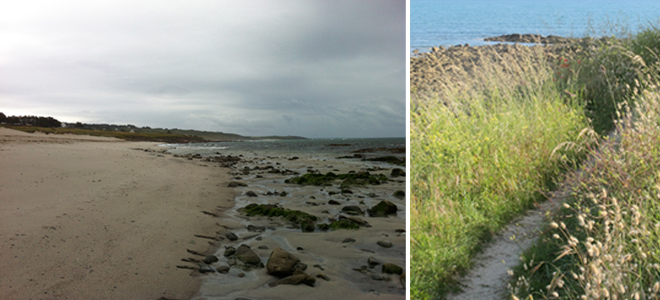
The profile of a typical Bretonnant speaker is a retired married woman with no educational degree living along the Finistere coast. Her husband was likely a fisherman, farmer or manual laborer and chances are that her children understand the language but don’t speak it. Ironically, the generation who speaks fluently is conflicted about Breton’s importance, as their parents (many of whom didn’t speak fluent French) were stigmatized as being primitive. What is now being taught in bilingual schools, and spoken on radio and TV, can be difficult for them to understand, as they speak more of a patois.
The statistical trend isn’t promising for a living language, with less than 2% of school children enrolled in bilingual school and just 3% of parents transmitting it at home. However, the reality of a language in decline hasn’t tarnished its stature as a symbol of regional pride.
We tuned into a Breton station for a few hours, and concluded that it’s unintelligible to French and English speakers. The only word I picked up was the German sounding “Ya” for yes. Breton most closely resembles Welsh, and like Wales, Bretons identify strongly with their traditions. Much of their identification is tied to a mythic past and heroic traits or stereotypes like rugged individualism and connection with nature.
Bretons describe themselves in the third person as independent characters that are stubborn, rebellious, hard working and sensitive. Having grown up in an Irish American family, I recognize the disconnect between talking the talk and walking the walk. If I’d proposed studying Gaelic instead of Latin or French, my parents would have told me to have my head examined. Speaking with a brogue was a stigma, just as having a Breton accent is tied to a lingering sense of inferiority among many elderly Bretonnants.
Unlike the Pays Basque, Brittany isn’t battling for autonomy or the sort of institutional independence Catalonia won in Spain. There’s a stronger sense of community here than in other regions of France, but also less xenophobia. Brittany voters have historically rejected the National Front party and tend to vote Socialist. While the rest of France considers the Brittany peninsula somewhat remote, Brittany has never perceived itself as isolated. The sea has always been its highway and its ports have welcomed visitors from Spain and the British Isles for centuries. It is closer to to England than Paris.

Plouhinec west of Quimper was our second Brittany filming destination. I tested Air BNB and found a modest three-bedroom house overlooking a sandy cove, down the road from the fishing port of Audierne. Stringent coastal zoning no longer permits construction close to the shoreline, but the owners of the house we rented are seeking permission to add on a needed second bathroom on the upper floor. With that addition, I would highly recommend it for two couples or a family with small children. The location, delightful view and price can’t be beat, and for those who enjoy cooking, the kitchen is well equipped. A Franco-British couple owns it and Sue the booking member of the couple and her trusty housekeeper couldn’t be more accommodating. Read More »

Beyond broad beaches of fine sand and gently rolling waves – 3 reasons not to miss this gracious seaside town in the Médoc wine region:
Just when you’re convinced there can’t be more hidden treasure along the Atlantic coast – you hit on a sleeper like Soulac. Why didn’t I know about this place? 100 kms north of Bordeaux and a hop across the Gironde estuary from Royan – it merits better name recognition. Soulac has the architectural potential to be a mini Savannah or South Beach of the French Atlantic coast, yet remains a little known family resort.
Arriving from the north or east, the easiest way to get there is a 30-minute car ferry from Royan. Leave time for a quick tour of the city. Royan is a brilliant white-painted concrete 1950’s time capsule. The old city was obliterated on January 5, 1945 by Allied carpet-bombing intended to annihilate intransigent Nazis. A massive urban renewal project attempted to compensate for thousands of citizens killed due to tragic miscommunication between an American general and the French military concerning evacuation.
A scenic alternate route is up the peninsula via Bordeaux. The winding road along the Gironde Estuary traverses fabled Chateaux vignobles – Margeaux, Latour, Mouton-Rothschild and Lafite – ending in Saint Estèphe, before leaving the undulating Haut Médoc terroir to enter the marshy flatlands of Médoc.
The landscape is a mixture of sand dunes and scrub pines on the ocean side, and marshland along the estuary. The eastern shore is scissor cut with minute tidal ports, where modest pleasure and fishing boats keep company with cabanes de pêcheurs cantilevered over the water on stilts. The most picturesque to my taste is Port de la Maréchale next to St-Seurin-de-Cadourne.

In mid March, Soulac was emerging from winter hibernation. Its population of 3,000 expands July through August to 55,000, but tourist season builds up slowly. My first hotel choice – Hôtels des Pins in Amelie Beach at the southern edge of town – opens in April, so we settled for Hotel Michelet, a small 2 star a block off the oceanfront. The establishment is impeccably clean and professionally run, but shrill décor, circa 1995, is hard on the eyes. Imagine the decorating section of a DIY homestore like Leroy Merlin.
The Michelet’s central location, plus sea views and a balcony in chambre 10, compensated for clashing color schemes. Philippe the proprietor couldn’t be nicer or better intentioned – even going so far as to deliver a breakfast tray at seven am.
Our Lady of the Ends of the Earth is an apt name for the Romanesque Basilica nestled at the heart of town. Back when Saint Veronica (buried in the church) was proselytizing the Gironde peninsula, the former Benedictine abbey at its tip was indeed remote. Were it not for occasional passage of St. Jean de Compostel pilgrims crossing the Gironde estuary, it would have been completely ignored.
Over the centuries, Soulac fell into obscurity as the dunes encroached on the Basilica to the point of swallowing it up. By the 18th century, farmers drove metal rings into the barely protruding stone towers to attach livestock. Today, pines teetering over the edge of the sandy cliff above Amelie Dune testify to ongoing errosion, and make it possible to imagine how a monastery could be engulfed over the centuries.

In the mid 1800’s, the fashion for bathing cures accelerated development of ‘Soulac-les-Bains’, and construction began of its charming Côte d’Argent style villas. Escavation and restoration of the Basilica in 1860 brought more visitors. A second wave of villa construction followed in the early decades of the 20th century with a more idiosyncratic ‘post colonial’ vernacular featuring turrets, pavilions, jutting wings, balustrades and porches. Lacey punched wood fretwork and terracotta roof tiles were de rigor, along with brightly hued painted wood trim.
Colonnaded first floor balconies evoke the architecture of French Caribbean and African island colonies. Each villa has a romantic or sentimental name enshrined on painted tiles, carved stonework or cursive script under the peak of a central eave above the front door. Stop by the Tourism office (next door to the cinema) for times of guided tours offered in several languages.

Ten to 15 years ago, a vintage gingerbread brick villa could be had for 40 thousand euros, but now a 75 m3 cottage & garden requiring work, sells for €350M (still a bargain by Cap Ferret standards, where a characterless shack goes for significantly more). Buyers are primarily French, while tourists are German and Dutch, with a smattering of British.
On your tour of centre ville, don’t miss the handsome market building. Its cavernous hall is filled with rows of food, wine, florist and flea market stalls. A side wing is devoted to fish and seafood. Open daily year round from 8am to 1pm, and again during July & August between 5 and 8 pm.
Restaurant choices in March were limited, especially midweek, but it’s evident that plenty of variety exists for summer vactioners. Tables on the glass veranda of Le Grill Océan on the Front de Mer enjoy an idyllic view of sunset over the beach – just the place to marvel at the conjunction of Venus and Jupiter in the velvet night sky on March 13. For seafood lovers, a €25 dinner menu includes large fresh oysters or a tureen of terra cotta hued fish soup as a starter, and grilled dorade or mussels in cream sauce for the main course. Desserts are homemade. Inexpensive white Bordeaux and Côte de Gasgones on offer. A 2009 Château de Teste provided a satisfying switch from Loire Valley white. La Villa Soulacaise, also recommended by our host, was closed for dinner.
The surprise of the visit was coming upon a replica of the Statue of Liberty perched atop a pedestal at the north end of ocean drive. It arrived clandestinely in Soulac in 1941 when French rail workers intercepted a train shipping it from Bordeaux to Germany, where it was destined to be melted down for armaments. In Bordeaux the statue had been the centerpiece of a giant fountain in Place Picard, but after the war Soulac held on to her.

Following Liberty’s gaze toward the horizon, you’ll spot the iconic silhouette of Phare Cordauan. Built in 1611, it is the oldest French lighthouse in service and the last to be inhabited full time. The lavish interior includes a chapel where weddings and baptisms take place. Nicknamed the Versailles of lighthouses, Cordauan is accessible at low tide on foot from neighboring Le Verdon-sur-Mer, if you are up for a 7-kilometer hike across the sand bar.
It’s hard to project how Soulac’s genteel ambiance is affected by summer crowds. In the old town center, streets are narrow and can’t handle much car traffic. Locals I met claim it remains off the radar despite development of the huge Médoc marina complex nearby, capable of harboring large boats.
The square and adjacent sidewalks in front of the Basilica were being renovated under supervision of historic preservation, so access roads were sealed off with metal grills. I managed to squeeze through a gap in the fencing and approached a group of stonemasons to inquire if the church was open. None of them spoke French, so I tried English and one happily spoke up. Not surprisingly they were Portuguese. Sadly the church was closed but they had no problem with me wandering around and I was able to admire exceptional carved stonework at the back. Another excuse to return in warmer weather to better sample Soulac’s ample charms.
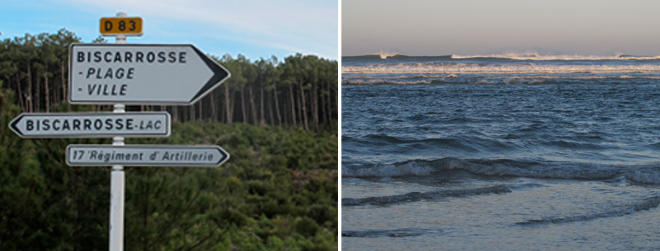
I’m at an adorable B&B overlooking the dunes in Biscarrosse-Plage on the Côte d’Argent, after accepting a seemingly seductive proposition. “How about if every month for a year, you came along for two to three days while I film the tide at one of twelve spots along the French Atlantic coast?”
The offer to be a video artist’s road buddy/logistical backup came from my husband Jeffrey, who concluded that as the youngest of our three children is soon to graduate lycée and leave the nest, it’s time to overcome resistance to accompanying him on working trips. The Arctic Circle (twice) and Bay of Fundy were easy to pass up, but he knows I’m a sucker for the French Atlantic coast, which has everything a landlocked girl from the Jersey shore craves, except sunrise over the horizon, salt water taffy and a boardwalk.
For once, I don’t get to pick the destinations. The twelve filming locations are equidistant and his schedule requires we leapfrog up and back, starting at the Spanish boarder, stopping at six points heading north and after reaching Pointe du Raz in Brittany, head back to cover six points on the way back down – ending up around Vieux-Boucau-les-Bains in December.
Creature comforts are my responsibility, being practiced at finding a charming chambres d’hôtes or intimate hotel*, and decent places to eat and drink. I’m not permitted to stray far a field from the filming location, as we have one car, and being PA on the project, I’m expected to set up and break down at appointed hours – which yesterday began at 7:30 am, with the thermometer registering 0 C, frost obscuring the windshield and a stiff wind whipping the filming tent atop the dunes.
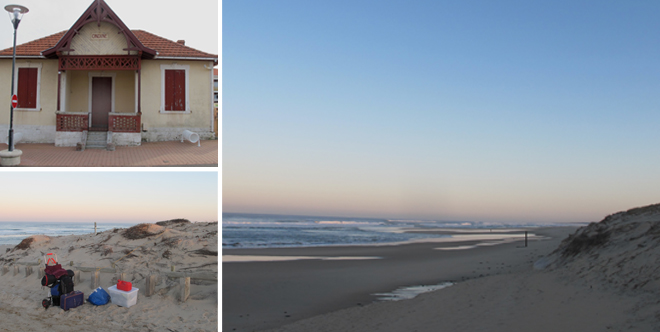
Agreeing to the scheme, I forgot that half the year – November through March, is pretty grim at the seaside, with shops and service establishments shuttered in all but larger towns midweek. Before Easter and after Toussaint, there’s a good chance many of the places I hope to see/try will be closed, but it is France, so there’s bound to be fresh seafood served somewhere, a boulangerie, and café with strong coffee, a galopin de bière, or verre de vin.
It’s a great opportunity to discover destinations like Biscarrosse, that I mightn’t otherwise be inclined to visit, and fill in my regional knowledge gaps. The natural beauty of the Atlantic coast is stunning. Cresting the dunes and confronting a broad sandy beach stretching into infinity, with waves crashing and gulls swooping, is a thrill I’ll never tire of. Thanks to protectionism imposed by the Loi Littoral in 1986, a break was put on development. For an American from the east coast, it’s refreshing to note that a serious effort was made to develop hiking trails along the coastline and permit everyone access to beaches.
So back to Biscarrosse, or ‘Bisca’ to habituees. It’s at the northern limit of les Landes, the 100 km of coast edged with pine forest that runs between Biarritz and the Bay of Arcachon in the Gironde. Les Landes has always been an isolated, sparsely populated region, although Biscarosse being an hour’s drive from Bordeaux, it is now becoming something of a bedroom community. The population swells more than tenfold in summer months, but now it’s getting to be lively year round – at least on weekends. For distraction midweek, Arcachon is less than a half hour’s drive north.
Popular has two meanings here. Unlike Biarritz and Arcachon, which developed as fashionable bathing stations in late 19th century due to an influx of British and European aristocrats and captains of industry, Biscarrosse was popularized by working class French after passage of the first mandatory paid vacation law in 1936. That year, 600,000 salaried workers left home for the first time on paid holiday leave and many headed for the coast. By 1982, France’s mandatory 2 weeks of paid vacation had extended to 5, and the camping grounds and holiday bungalows around Biscarrosse-Plage and its sister town, Biscarrosse-Ville ( located between the shores of two enormous lakes) expanded along with the swelling crowd of vacationers.
The beach at Biscarrosse has the added attraction of having two enormous fresh water lakes alongside it. Northern Lake Cazeaux is where most of the action is concentrated, along its south-west and southern shore. There is a Pierre & Vacances golf course resort, several sandy beaches, and ports filled with sail and motorboats. Because there is no access to the sea from the lakes, very few ocean going pleasure boats and fishing vessels pass by the on the horizon. It also explains why Biscarrosse hasn’t become a tony resort, as there is no ocean harbor for glitzy yachts to dock.
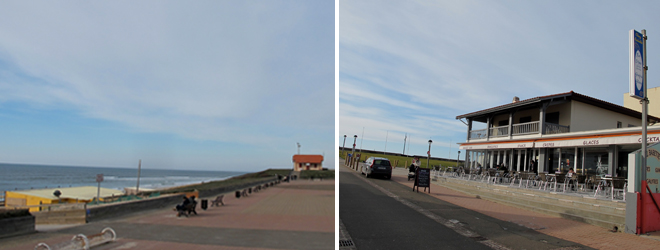
Tents have disappeared from the camping grounds, replaced by RVs and bungalows. Several have five star ratings, with full service facilities, grocery stores, tennis courts, miniature golf, and a host of organized water sports and leisure activities. They draw families from all over France, along with a significant contingent of Dutch, German, Belgian and British tourists.
12 surf shops and 4 schools in Biscarosse-Plage testify to a boom in long and short board surfing, now a veritable craze along the south Atlantic coast. Surfing, like skate and snow boarding, has engendered a flurry of youthful tribes, with distinct subcultures. Along with surf shops, Biscarrosse-Plage has the requisite neo hippy clothing boutiques, piercing/tattoo studios and enough pizza and waffle shops to sate carbo cravings.
The first summer vacation cottages were built in the teens, with subsequent development surges in the 1930’s, 50s and 70’s. Many of the period houses have been restored and added onto. Judging from some unsightly 1970’s apartment blocks and ugly commercial facades, it would seem that many of the old cottages were razed opposite the oceanfront promenade.
The beach is majestic, as it is all along the Côte d’Argent, the longest and wildest sandy shoreline in Europe, which runs the length of the Landes and Gironde departments. The dunes are high, requiring strairways down to the beach. If you want to avoid high season crowds on the strip below the promenade, you can head a bit further north to Vivier Plage. Getting to the water requires a walk through the pines and a scramble down the dunes but the reward of relative isolation is worth it.
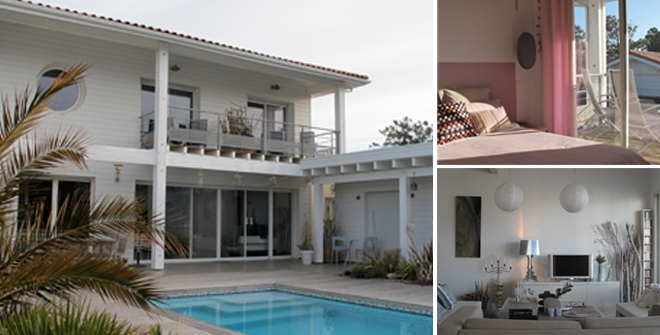
Philippe Pascutto, the delightful host of Cote & Dune is a surfer himself and borrowed the theme as the design motif for his sunny, beach centric chambres d’hôtes. A native of the region, Philippe returned after 25 years working at an IT job in Paris to pursue his dream of living by the sea. His contemporary home is built around a central courtyard, replete with sleek pool and teak decking. All but one of the 5 surf themed guestrooms has a balcony, roof deck or terrace. Once air warmed to 10 C, the sun drenched balcony of pink hued ‘Malibu’ was a relaxing spot for a read, wrapped in a polar throw provided for just such occasions.
Philippe has visited some of the world’s best beaches, and the guestrooms are decorated with travel books and funky-chic travel mementos from Hawaii, Brazil, Costa Rica, California and Australia, along with inventive shell and driftwood decorative objects created by his partner, a talented interior designer who oversaw the creation of the project in 2010.
Elegant landscaping features succulent and native sand-loving flowing plants that create a harmonious counterpoint to the fresh, upbeat ambiance of the interior. The rooms are compact without being cramped, with well appointed open-plan bathrooms to optimize a sense of light and spaciousness.
Breakfast is served at a long white table in the central dining section of your hosts’ loft inspired living area. In a designer’s home, nothing is left to chance and every detail, from the cluster of shells adorning your place setting, to the reglisse flavored ‘black honey’ and home made mini canelés, is picture perfect.
Philippe has excellent suggestions for dining and touring. Having a good working relationship with local restaurants and the tourist office, he was able to quickly resolve a few logistical snafus. Once you’ve had your fill of beach-combing and walks through the pine forests, I suggest heading to Pyla and Arcachon, if just to see the idiosyncratic and often opulent architecture of villas in the old neighborhoods and climb on the tallest sand dune in Europe.
On Sunday and Monday night, dining options around Bisca were slim, but we enjoyed a satisfying menu du jour at Le Bleu Banane, a contemporary bistro serving simple but well prepared French staples. It’s terrace ajoins the large central pedestrian square a few blocks back from the waterfront. The chef, a fourth generation local, filled us in on the history of the town. It grew up around a rail station for transport of resin tapped from surrounding pine forests. Resin extraction, which resembles maple syrup sugaring, was a labor-intensive process. Many of the resiniers were former shephards sqeezed out of a livlihood when more profitable pine forests were planted over their marshy pastures. They lived a simple existence in cabins, many of which were subsequently converted into summer cottages. The demand for domestic, natural resin diminished with competition from cheap overseas and synthetic supplies, and the industry died out in 1990. I should add that the 2006 Rioja he recommended was the ideal accompaniment to a perfectly cooked onglet de boeuf.
Isolation provided by the biggest forest in Western Europe led to requisition in the 1960s of tens of thousands of acres just south of Biscarrosse by the French government to create Europe’s leading missile test center. The high security facility maintains a low profile and doesn’t seem to bother residents, in part because it has hampered coastal development.
Despite initial aesthetic reservations, I left with fondness for this throwback of a seaside town. It is unpretentious and friendly; rare attributes for a French coastal resort. With real estate probitive in the oh so chic Gironde resorts of Pyla, Arcachon and Cap Ferret, Biscarrosse might just be on the cusp of a full fledged makeover.
* I’ve not received a discount, let alone a freebee at any of the chambres d’hôtes or hotels mentioned in my blog.

The French Atlantic coast trends to melancholy midwinter, but Hendaye on the Spanish border is an exception. You know you’ve landed in a surfing mecca if it’s January, barely above freezing and pelting rain, yet dozens of neoprene-hooded heads are bobbing in the breakers. Seafront parking is jammed until sunset, when the diehards reluctantly emerge from the waves, and peel off wetsuits right on the street in their haste to get into something warm and dry.
Hendaye has a health-conscious, sporty vibe – with a steady passage of cyclists, runners and hikers rounding the harbor, beachfront and vertiginous corniche road tracing the coast up to St Lean de Luz. People are out and about at all hours, even if it’s just walking a dog along the waterfront.
Hikers know it as the Atlantic departure point for the ambitious G-10 trail, which crosses the Pyrenees to the Mediterranean along the Franco-Spanish border. Thalasso-spa Serge Blanco, which was closed for renovation, is also a popular draw.
Hendaye lies on the north bank of the Bidossoa River, where it meets the sea at the Bay of Chingoudy. The Spanish town of Fontarabie is across the bay to the South, and the massive Deux Jumeaux (Two Twins) rocks rise up from the sea below the cliffline to the north.
The well-protected harbor permits pleasure boats to dock year round. There’s also an active fishing community of open sea vessels and anglers off the jetty. Didn’t see any sailboats in action but a club of rowers showed up at dusk to practice off the fishing dock, while kayakers meandered around the bay.
A mere trace remains of historic L’Isle de Faisons, rendezvous point for royal and diplomatic exchanges over the centuries between Spain and France because of it’s strategic, face-saving location off the mainland. In 1526, Francois I was traded for two of his sons after being captured at the siege of Parvis, Anne of Austria, bride of Louis XIII, entered her new country here in 1615, and in 1660, the marriage contract of Louis XIV with the Infanta of Spain was signed in a pavilion designed for the occasion by Velasquez, as a term of the treaty which concluded 30 years of warfare between the rival nations.
The town is divided between Hendaye-ville (train station, town hall, businesses and principal shopping district) and leisure-centric Hendaye-plage (beach, port de peche, port de plaisance, thalasso, hotels and casino).

We stayed at Villa Goxoa, a pleasant family run micro hotel on a magnolia-lined residential street, equidistant between the beach and harbor. Owners Nathalie and Marc Applagnat inherited the house and gutted the interior three years ago to create a minimalist contemporary nine-room hotel. Rooms are small and lack a bit of character, but impeccable, with comfortable beds, good sheets and pillows. Several have a small balcony or terrace. Bathrooms proportionately bigger and well appointed, though only one double is equipped with a bath. Satisfying breakfast of OJ, yogurt, fresh fruit salad, croissants, baguette, whole grain bread and a pot of strong coffee. Off-season, a double runs €85-95 euros, plus €10 for breakfast. Read More »

Never made an effort to visit Nice. When you live in Europe long enough, certain destinations like Ibiza or Prague acquire inevitability – you presume you’ll get there eventually. It took 25 years for an invitation to celebrate a friend’s birthday to make it happen. Unseasonably hot weather intensified tourist density, but the city’s irrefutable charm trumped my Cote d’Azur phobia.
Reality matched the improbable cover of a brochure titled “Nice, a natural brilliance” picked up at the airport – featuring a salmon pink building with sunflower window trim and mint shutters, silhouetted against an azure sky behind a fringe of palm fronds. At sunset, certain buildings seem lit from within. Graced with miraculous light, the lemon, ochre and terra cotta facades adorned with delicate stucco manage to appear elegant rather than garish. The mixture of 19th century and deco architecture reminded me of Montevideo, as does the sinuous Promenade des Anglais tracing the waterfront.
Wish I’d experienced Nice before it was France’s number two tourist destination, when the tropical bravura was still leavened with a patina of melancholy. Summer stretches from May through October and the balmy winter keeps people coming right through. Heavy pedestrian traffic made it hard to fully appreciate gracious Place Masséna, the old town and waterfront – the way viewing a masterpiece across three rows of shoulders in a museum is dissatisfying.
The historic old town isn’t drained of residential vitality. Locals still shop and gather in cafes lining the narrow shaded streets below the citadel. The famous flower market running parallel to the shoreline is worth a visit. Also recommend the vélo bleu, Nice’s answer to the Paris Velib bike rental circuit. I challenge you to make it up the hill to the Matisse museum – a true three-gear feat.

Sunday morning I witnessed quite by chance a frankly outrageous religious celebration in the Basilica Cathedral of Sainte Marie–Sainte Réparte. October 5th is the feast of Sainte Fleur, the patron saint of florists and since 1996, it’s celebrated on Sunday closest to the date. My first impression seeing the riot of red, white and green floral arrangements was that I’d crashed a mafia wedding. The display was so over the top, adorning every conceivable focal point. Several priests concelebrated mass surrounded by five flower-bedecked beauty queens seated facing the congregation with rapt smiles on their meticulously made up faces. It was like watching mass on a carnival float. Four of the Femmes-Fleurs represented the seasons, and a stunning blond in royal blue trimmed with golden yellow blooms, represented Nice-la-Belle. The cut flower industry is big business in the region and the event felt like a feast cooked up with the chamber of commerce. A priest at the end of the service thanked the 30 participating florists and of course the mayor. Turns out this was the main event of an annual two-day Fête de la Sainte-Fleur festival.
The diocese of Nice is clearly in the vanguard creating special events to draw in the faithful. The Sunday edition of Nice Matin covered the benediction of hundreds of portable phones earlier in the week on the feast of archangel Gabriel, patron of communication. When questioned whether his blessing had the support of senior clergy, father Gil Florini happily reported that his bishop texted approval. This week, pets are invited on the feast of Saint Francis.
Bravura and extravagance are synonymous with France’s most southern and Italian city. Long property of the King of Sardinia, it was annexed by France in 1860 and has been colonized since by generations of British sun seekers. A weekend with the distractions of a birthday celebration was far too brief a visit. Looks like I’ll be returning, but preferably in March or November.

La Part des Anges: Found on lefooding.com. Wine bar favoring natural producers, with daily menu featuring fresh local, organic and artisinal produce. Rustic décor, relaxed ambiance & friendly welcome. Lunch, Monday-Saturday. Dinner, Friday & Saturday. Limited seating, so reserve for dinner.
La Pizza (Cresci): Nice’s oldest pizza restaurant in business since 1956. Wood-fire oven, unpretentious décor & terrace on pedestrian street. Recommend the aubergine. Arrive with an appetite.
Birthday celebrations were held at two chic eateries: dinner at La Petite Maison in the old town, and lunch at La Guérite on Ile Sainte-Marguerite, the larger of iles de Lérins in the bay of Cannes.
Hard to judge a restaurant from fixed menus served to 80 guests, but the settings were fun and libations flowing. La Petite Maison seems a tad spoiled by success, but La Guérite, enjoys an idyllic pied dans l’eau setting on the quiet side of the island. The scenic boat ride from the Nice port takes an hour.
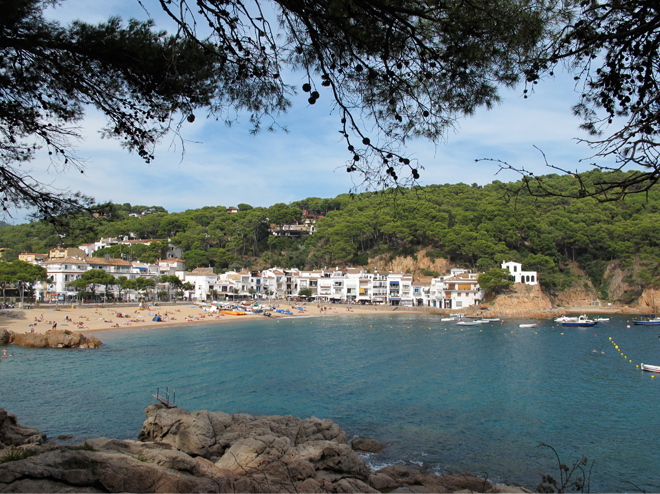
Sensing a wince of regret. Certain places you hesitate sharing, like the stellar friend you’re reluctant to introduce around for fear of diluting your quota of their affection. So I’ve stalled, but failed to repress sparkling flashbacks of Tamariu’s low key charm and exceptional setting.
Sampler of its seductions:
Clearest European seawater I’ve experienced that isn’t icy cold.
Kaleidoscopic trove of softly rounded stones at water’s edge you can’t resist pocketing.
Family tableau featuring three generations of women reclining in scant bikinis or topless – looking more comfortable in their skin than modesty police could bear.
Vertiginous hike along the shoreline to a beach shack bistro one cove over, accessible only by foot or boat. Clambering over rocks, then up and down a narrow path along the pine shaded precipice. Unfortunately it was off-season and the kitchen closed just as we scrambled down the hot cliff side at 14h30. Settled for scrumptious potato chips, a cool San Migel and marveling at the craggy scenery, before confronting the half hour return trek.
Tamariu is fishing village resort gem – crescent moon beach ringed by a boardwalk with a couple of shops and a few more restaurants, all cradled within a backdrop of rocky coastline and a steeply rising pine-covered hillside.
Read More »
© Copyright 2024 Casey O’Brien Blondes - Privacy Policy | Design by Weller Smith Design
Do NOT follow this link or you will be banned from the site!